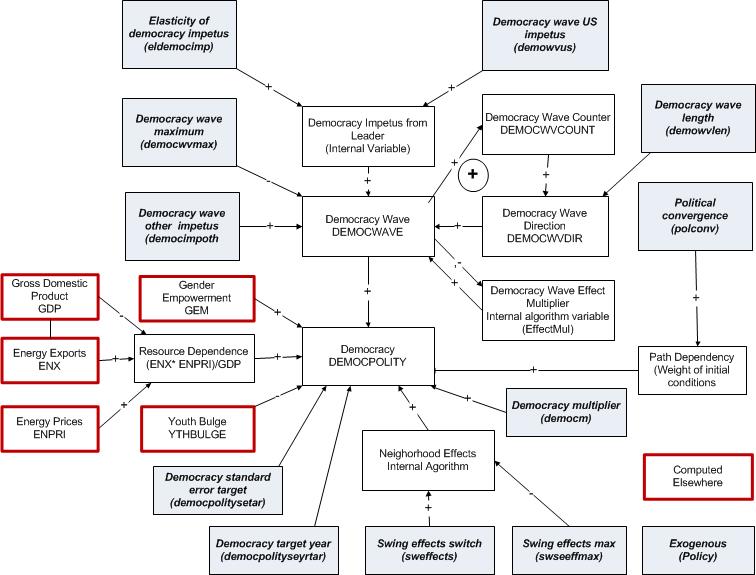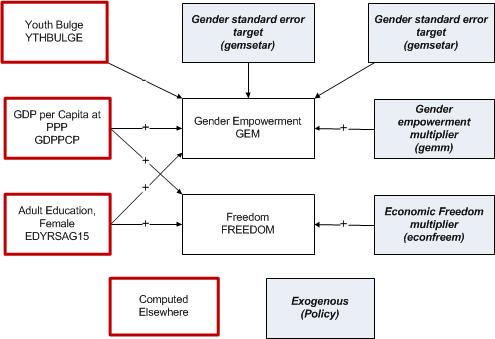International Futures Help System
Inclusiveness
Democracy
Three variables dominate the forecasting formulation for democracy (DEMOCPOLITY): the gender empowerment measure (GEM) as a measure of broad social inclusion (positive linkage), the youth bulge (YTHBULGE) as an indicator of the age structure of society (negative linkage), and the dependence of the country on raw materials exports, a negative linkage using energy export share (ENX) times energy prices (ENPRI) as a share of the GDP as a proxy. An exogenous multiplier ( democm ) allows the user to directly manipulate the democracy level.
Two other variables can affect the democracy level but are turned off in the Base Case and will seldom be used. The first is the neighborhood effects of swing states in a regional neighborhood (e.g. Russia among former states of the Soviet Union). The swing states effect switch ( sweffects ) turns it on when set to 1.
The more complicated additional factor is that of democracy waves (DEMOCWAVE). Relative to the initial condition a democracy wave can add or subtract democracy to the basic formulation's calculation of it (an algorithm based on historical experience allows upward swings to be larger than downward ones depending on EffectMul). The basic magnitude of increments depends of an exogenous specification of the impetus provided to democracy by the leading power ( democwvus ) and by other powers ( democimpoth ), the former's impact controlled by an elasticity ( eldemocimp ). Because waves rise and ebb, another parameter controls the length ( democlen ) and still another sets the maximum rise ( democwvmax ). A counter keeps track of the running and receding of a wave (DEMOCWVCOUNT) and a pointer keeps track of the direction its operation (DEMOCWVDIR); these two parameters are linked with the magnitude of the wave in a positive loop.
The calculation from the basic formulation, before the addition of wave and swing state or neighborhood effects, can also be overridden by the use of external targeting directed by specifications of standard error targets relative to the formulation ( democpolitysetar ) to be achieved by a target year ( democpolityseyrtar ).

Gender Empowerment and Freedom
Gender empowerment (GEM), a broader measure of inclusion, joins democracy as the second key measure of governance inclusiveness. Its three basic drivers are youth bulge size (YTHBULGE), GDP per capita as purchasing power parity (GDPPCP), and the years of formal education obtained by female adults (EDYRSAG15).
A user can control the progression of gender empowerment with a simple multiplier ( gemm ) or via setting a target value for it movement to some number of standard errors above or below a cross-sectionally estimated function ( gemsetar ) across a set number of years ( gemseyrtar ).
Although IFs uses the Polity measure of democracy (DEMOCPOLITY) as its main measure of more formal, electoral inclusion, Freedom House's freedom measure (FREEDOM) is a logical alternative and the second of that measure's sub-dimensions, civil liberties, is a more inclusive measure. We therefore compute it also, using again GDP per capita and educational years (of all adults, not just females) as drivers. And there is a brute force multiplier for it also ( freedomm ). There is no SE targeting mechanism in place for the freedom variable.

 International Futures at the Pardee Center
International Futures at the Pardee Center